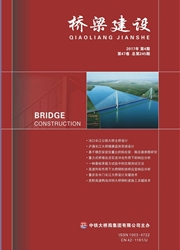

 中文摘要:
中文摘要:
为寻找合理可行的颤振控制气动措施,使超千米跨径斜拉桥的颤振临界风速超过80m/s,以主跨1 400 m的钢箱梁斜拉桥设计方案为背景,通过节段模型风洞试验对中央稳定板、中央开槽、悬臂水平分离板、风嘴锐化等各种超千米斜拉桥颤振控制气动措施的效果进行了研究。研究表明:1.5 m悬臂水平分离板加40°锐化风嘴角的颤振控制组合气动措施,能够显著改善桥梁的颤振性能、实现颤振临界风速不低于80 m/s的目标;从颤振稳定性角度验证了1 400 m斜拉桥方案的可行性;超千米斜拉桥的颤振稳定性的富余度往往不高,设计必须考虑斜风效应的不利影响。
 英文摘要:
英文摘要:
To find out the rational and feasible aerodynamic measures for flutter control and to ensure that the flutter critical wind speed of the cable-stayed bridge having span length longer than 1 000 m can be raised to a level of 80 m/s,the proposed design of a 1 400-m span steel box deck cable-stayed bridge was cited as an example and the effect of different aerodynamic measures,including the central stabilizing plate,central slotting,cantilever horizontal splitting plate and wind fairing sharpening,for flutter control of the cable-stayed bridge having span length longer than 1 000 m were investigated through sectional model wind tunnel tests.It is concluded from the investigation that the combined aerodynamic measure of the 1.5 m cantilever splitting plate and the 40° sharpened wind fairing angle can significantly improve the flutter performance of the bridge and can achieve the target of the flutter critical wind speed that is not lower than 80 m/s.The proposed design of the 1 400-m span cable-stayed bridge is proved to be feasible from aspect of the flutter stability,however the margin of the flutter stability of the cable-stayed bridge having spanlengthlonger than 1 000 mis of ten not high andin the design of such type ofthe bridge,the unfavorable influence of yaw wind effect should be takeninto account.
 同期刊论文项目
同期刊论文项目
 同项目期刊论文
同项目期刊论文
 期刊信息
期刊信息
